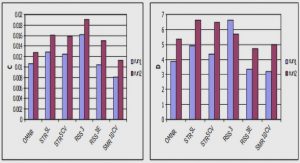Get Complete Project Material File(s) Now! »
CHAPTER TWO LITERATURE REVIEW
CHAPTER OVERVIEW
The review of the literature is divided into three sections. The first section introduces briefly the historical definition of resilience and trauma and its conceptualization. The second section of this chapter reviews empirical research studies on the internal and external factors that contribute to resilience after trauma such as spirituality, personality and social support. Finally the theoretical concepts of resilience and trauma are reviewed.
DEFINITION AND CONCEPTUALIZATIONOF RESILIENCE
In psychology, the focus of resilience paradigm is on the individual. Fletcher and Sarkar (2013) emphasized that “it is the study of psychological resilience that seeks to understand why some individuals are able to withstand – or even thrive on – the pressure they experience in their lives” (p. 12). Numerous definitions and conceptualizations regarding resilience appear in the literature despite most of the definitions being based on concepts of ‘adversity’ and ‘positive adaptation’ (Fletcher & Sarkar, 2013). Positive coping, persistence, adaptation, and long-term success despite adverse circumstances are often considered to be synonymous with resilience (Winfield, 1994). Some other definitions also appear in the literature. For example, Lösel (2005) defined resilience in terms of processes of protection, repair, and regeneration in analogy to biological processes. Amering and Schmolke (2009) asserted that resilience was used to imply the power to resist, mental elasticity and regaining the former mental stability following a stressful period or event in clinical psychology and psychotherapy. Kelley and Pransky (2013) equated psychological resilience with inner health and asserted that “innate resilience…is the essence of a balanced, healthy state of mind evidenced by the logic of fundamental principles that appear to account for all human experience” (p. 2). Nevertheless, there is seemingly no consensus between researchers on the definition of resilience. Research literature indicates that there are different conceptualizations of resilience and researchers focus on resilience from different viewpoints. Literature on resilience include debates on whether resilience is a process or outcome, whether it is a process or trait, whether it is in born or acquired competency and how it can be distinguished from vulnerability.
Listing the definitions by several authors from 1991 to 2005, Manyena (2006) suggested that there has been a gradual refinement in the conceptualization of definitions from more outcome-oriented to more process-oriented definitions. Other researchers argued that resilience is a process oriented and cannot be understood in terms of static factors (Rutter, 1987). Cutuli and Masten, (2009) suggested that resilience cannot be viewed as a single trait because it involves many systems derived from individuals, families and societies. This argument emphasized that any effort to operationalize resilience as a universal trait is misguided.Some researchers have used the terms resilience and resiliency synonymously (Miller, 2003).Masten (1994) suggested that the term resilience is process-oriented and on the other hand the term resiliency is more focused on an individual’s internal traits. Early conceptualizations of the resilience construct was based on the ego resilience concept (Block & Block, 1980; Block & Kremen, 1996) which reflected the strength and maturity of the ego in the face of adversity.Blocks (1980) theorized ego-resiliency as a central personality construct offering adaptive flexibility; the definition given by this author “the dynamic capacity of an individual to modify his or her modal level of ego control, in either direction, as a function of the demand characteristics of environment” (p. 48). Individuals with highly ego-resilience could adapt and be in control of themselves in times of adversity based on the environmental conditions compared to individuals with low levels of ego-resiliency who were more likely to behave in a maladaptive manner. As a result, these individuals were conceptualized to be more likely to experience self-confidence, positive affect, and overall psychological adjustment (Block & Kremen, 1996).
SUMMARY
DECLARATION
ACKNOWLEDGMENTS
TABLE OF CONTENTS
LIST OF TABLES
LIST OF FIGURES
LIST OF ACRONYMS AND ABBREVIATIONS
CHAPTER ONE
INTRODUCTION
1.1 Motivation Of The Study
1.1.1 The Link Between Spirituality And Resilience
1.1.2 Case Study
1.2 Problem Statement
1.3 Research Aim
1.4 Objectives Of The Study
1.5 Research Questions
1.6 Rationale
1.7 Theoretical Framework
1.7.1 Richardson’s Meta-Theory Of Resilience And Resiliency
1.7.2 Joseph And Linley Organismic Valuing Theory
1.8 Definition Of Operational Terms
1.9 Chapter Summary
CHAPTER TWO LITERATURE REVIEW
2.1 Chapter Overview
2.2 Definition And ConceptualizationOf Resilience
2.2.1 Models Of Resilience
2.3 Factors Affecting Resilience
2.3.1 Age And Resilience
2.3.2 Gender And Resilience
2.3.3 Personality Traits And Resilience
2.3.4 Spirituality
2.3.5 Social Support In Relation To Resiliency
2.4 Chapter Summary
CHAPTER THREE RESEARCH METHODOLOGY AND DESIGN
3.1 Chapter Overview
3.2 Research Design
3.3 Research Instruments
3.3.1 Connor-Davidson Resilience Scale (Cd-Risc
3.3.2 Social Support Questionnaire And Spirituality Questionnaire
3.3.3 Socio-Demographic Questionnaire
3.3.4 Interview Schedule
3.4 Research Setting
3.5 Sampling Strategy
3.6 Pilot Study
3.7 Data Collection Procedure
3.8 Reliability
3.9 Validity
3.10 Data Analysis
3.11 Ethical Considerations
3.12 Chapter Summary
CHAPTER FOUR DATA ANALYSIS, RESULTS AND FINDINGS
4.1 Chapter Overview
4.2 Demographic Data
4.3 Internal Factors That Influenced Resilience Among Victims Of The Fire Tragedy In Kiambaa
4.3.1 Age And Resilience
4.3.2 Gender And Resilience
4.3.4 Personality And Resilience
4.4 External Factors That Influenced Resilience Among Victims Of The Fire Tragedy In Kiambaa
4.4.1 Spirituality And Resilience
4.4.2 Forms Of Social Support
4.5 Significant Internal And External Factors That Contribute To Resilience In Male And Female Victims
4.6 Chapter Summary
CHAPTER FIVE DISCUSSIONS, CONCLUSIONS AND RECOMMENDATIONS
5.1 Chapter Overview
5.2 Discussions
5.2.1 Internal Factors That Influenced Resilience Among Victims Of The Fire Tragedy In Kiambaa Village In Eldoret East Sub-County Of Uasin Gishu County
5.3 Personality As A Resilience Factor
5.3.1 Big Five Personality Traits And Resilience
5.4 External Factors That Influenced Resilience Among Victims Of The Fire Tragedy In Kiambaa Village In Eldoret East District Of Uasin Gishu County
5.4.1 Spirituality And Resilience
5.4.2 Social Support And Resilience
5.5 Relationship Between Resilience And Internal And External Factors Of Internally Displaced Persons After The Experience Of Trauma
5.6 Conclusions
5.7 Recommendations
5.8 Limitations Of The Study
5.9 Suggestions For Further Research
REFERENCES
APPENDICES:





